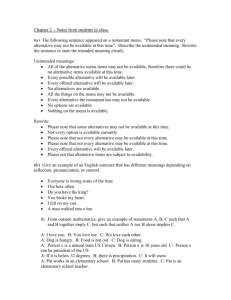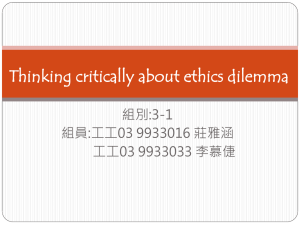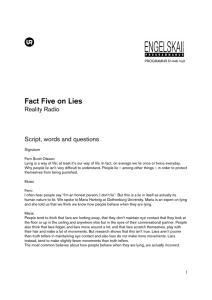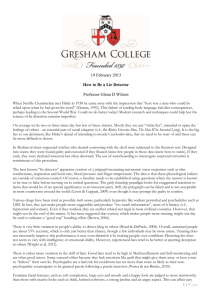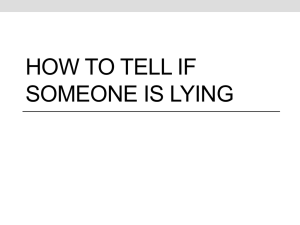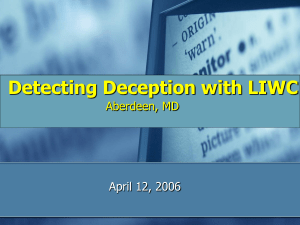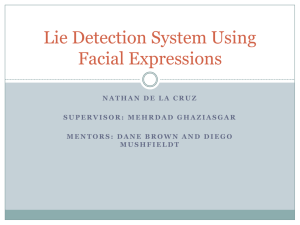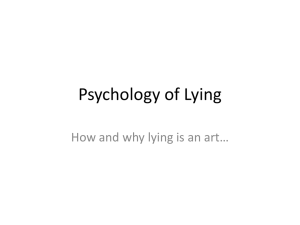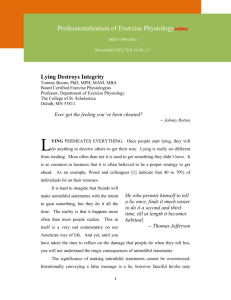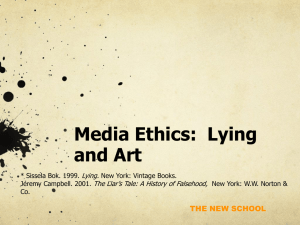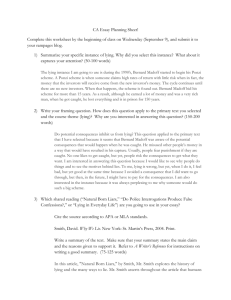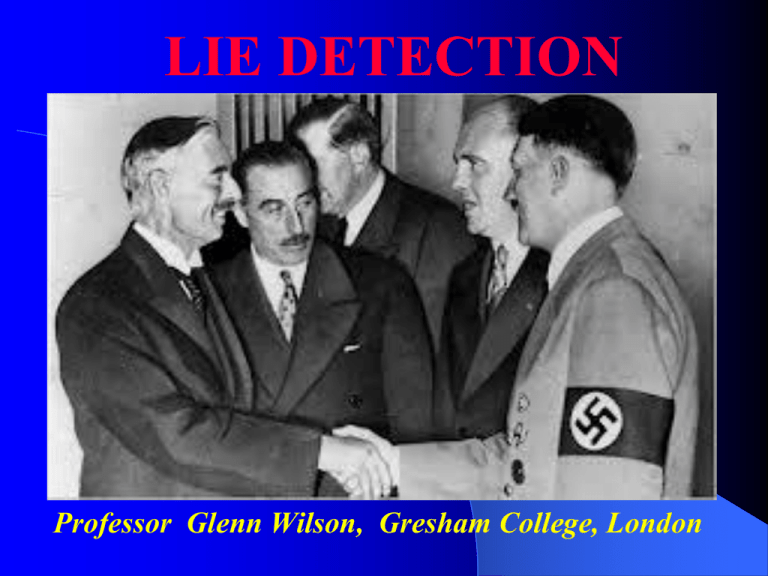
LIE DETECTION
Professor Glenn Wilson, Gresham College, London
LIES BIG AND SMALL
Chamberlain: “I came away with
the impression that here was a man
(Hitler) who could be relied upon
when he had given his word”. A
failure of lie detection with dire
consequences.
On average, people admit to lying
two or three times a day. Most not
sinister - just white lies, designed
to spare feelings of others (an
essential part of social etiquette).
High stakes lying regarding guilt in
relation to murder or terrorism
follows different rules.
FLOATING WITCHES
Mediaeval witches who
denied their witchcraft
were tested by dunking
them in water.
If they “floated” (could
swim) they were found
guilty and put to death. If
innocent, they sank and
drowned.
Waterboarding suspected
terrorists is reminiscent of
this technique.
THE POLYGRAPH
Best-known lie detector uses
autonomic (unconscious)
indicators of stress such as
skin conductance, heart rate,
respiration, blood pressure
and finger temperature.
Skill is in choosing questions.
Must include controls (where
the correct answers are
known) as a baseline for
comparison.
Guilty knowledge paradigm
most valid (items only a guilty
suspect should react to).
Results unreliable and not
acceptable in court.
IN VINO VERITAS?
Hypnotics and psychedelics
tried as possible truth serums.
In fact, they just make people
more suggestible & obliging,
so they tell you what you
want to hear (c.f., hypnosis
and torture).
Yield more fantasy than truth,
hence not useful (apart from
being unethical and illegal).
Suggested that oxytocin may
increase trust, thus boosting
“good cop” bonding effect
(Brown, 2006).
SPOTTING LIARS
Untrained observers about 53%
accurate in detecting lying
through body language
(marginally better than chance).
Most experts are little better
(with a few exceptions).
Training can diminish accuracy
by inducing overconfidence
(Bond & DePaulo, 2008).
Accomplished liars are better at
detecting lies (“it takes one to
know one”).
(Wright et al, 2012)
GOOD LIARS
More variation in lying skill than
in ability to detect lies.
Effective liars are high in
Machiavellianism and selfmonitoring and usually good
actors. May succeed because
they lack emotions like guilt or
come to “believe” their own lie.
Psychopaths twice as likely to
be granted parole as nonpsychopaths following an
interview, despite being more
dangerous after release (Porter
& ten Brinke, 2010).
TRUSTWORTHY FACES
Faces with soft, feminine
features such as a smooth,
warm complexion, large
mouth and rounded jawline
(baby-faced) are judged
more trustworthy. Those
with macho traits like
bushy, knitted brows, facial
stubble, wide nose, small
mouth (and angry look) are
seen as less trustworthy.
Can affect jury decisions
and court sentences
unfairly but stereotypes not
totally without foundation
(Sirrat, 2010).
Gordon Brown (a), digitally altered to be more
(b) and less (c) trustworthy.
(Chris Solomon, Univ. Kent).
ILLUSTRATORS
Gestures that reinforce what is
being said suggest emotional
involvement, hence sincerity.
If a gesture does not match what is
being it suggests deception.
Dominant hand used more in
connection with +ve emotions; nondominant for -ve ones.
Deception goes with a decrease in
illustrators compared with
individual’s norm (over-control of
body language) but may not apply
when stakes are very high (Porter &
ten Brinke, 2010).
MICRO-EXPRESSIONS
Fleeting expressions, often
detectible only by slowmotion video, may betray
emotions that individual is
trying to hide.
Absence of appropriate
emotion (e.g., grief) is equally
telling.
System of reading facial
expressions of emotion
developed by Paul Ekman
widely applied (basis for “Dr
Cal Lightman” in Lie to Me).
Criticised as lacking empirical
validation (e.g., occurrence of
false positives).
EMOTIONAL LEAKAGE
Face sometimes betrays true
emotions when inappropriate
feelings break through a social
façade (Porter & ten Brinke, 2008).
Micro-expressions of disgust and
anger displayed by Kato Kaelin as
he “charmed” the prosecutor in
testimony for O.J. Simpson
(Ekman, 2003).
Asked to curtail smiling and brow
movements during true and false
accounts, liars are less able to do
so (Hurley & Frank, 2011).
Kim Philby (“the third man”) was
unable to contain a smirk while
denying he was a Russian spy.
Tracie Andrews stabbed fiance to death,
then fabricated a story about a road rage
attack. Her TV appeal featured distress
and grief but occasional flashes of anger
intruded, giving clues as to her
capability.
SMILES FAKED VS FELT
Contrived expressions differ
from those that are
spontaneous.
Felt smiles include wrinkling
around the eyes and cheeks.
Faked smiles more restricted to
mouth, show lower teeth, often
asymmetrical and contain
elements of negative emotions
such as anger or disgust.
Felt smiles generate more
empathy and trust in others.
Skilled actors can smile
convincingly by conjuring
happy feelings.
EYE MOVEMENTS
Popular belief that liars avert their
eyes not reliable because people
can over-ride this tendency.
NLP claim that looking up/left
indicates genuine memory recall,
whereas up/right is accessing
creative brain (“making it up”) is
not supported by evidence
(Wiseman et al, 2012).
Computerised eye tracking more
promising - compares patterns to
critical (searching) questions
against individual’s own neutral
baseline. Reported as 82% accurate
(Bhaskaran, 2011).
STRESS SIGNS
Signs of emotional arousal - blinking,
blushing, sweating, dry mouth
(drinking water) may indicate lying.
But many other reasons for feeling
stressed during public speaking or
during interrogation, so not sufficient
indictment in themselves.
Same true for self-comforting
gestures such as folding arms and
touching the face.
Blink rate actually often lower in liars
(another example of over-control).
An absence of appropriate distress
(esp. in the upper face) may be
equally telling.
LIP PRESSING
Lip swallowing (sucking the lips
inwards) usually accompanies
thinking and uncertainty about
something (especially when the
outcome might be bad).
Lip compression is associated
with lying (DePaulo & Morris,
2004). May represent desire to
control the urge to blurt out
something that one would prefer
the world not to know
(“buttoning the lip”).
THE PINOCCHIO EFFECT
Touching the nose - classic
sign of discomfort and selfconsciousness.
According to Hirsch & Wolf
(2001) this is because the nose
contains erectile tissue causing
it to become engorged with
stress.
When Clinton was denying
sex with Monica Lewinsky he
was observed to touch his
nose particularly at moments
of untruthfulness.
VOICE STRESS ANALYSIS
Various computer & phone
applications claim to detect
lying through microtremors in the voice and
higher pitch.
Scientific studies (e.g.
comparing VSA of drug
users denying use of drugs
against urine analysis)
shows them to be little
better than chance.
At best, detects stress, not
lying specifically, but like
the polygraph, may be
useful in prompting
confessions.
THERMAL IMAGING
Infrared cameras are being
tested as lie detection tools at
airports (already used for
fever detection).
Asked to lie about their
travel plans, skin temp.
around people’s eyes rose
significantly (no change for
truth tellers).
64% of truth-tellers & 69%
of liars correctly classified.
However, interviewers’
judgements were more
accurate (72% & 77%).
Thermal imaging added
nothing significant to this
(Warmelink, 2011).
LIES IN THE BRAIN
Brain activity (fMRI) may
capture a lie “at its source”.
Theory is that telling the truth
just involves memory but lying
requires (a) suppression of the
truth, (b) invention of a new
scenario. Lying should thus
engage more frontal (and
perhaps parietal) areas.
Claims of 90% accuracy have
been made for this approach but
premature to use as evidence in
court (Langleben & Moriarty
(2012). Not immune to cheating
by self-stimulation in control
condition (Ganis et al, 2011).
PUNE POISONING
In a Mumbai courtroom
(2008) Aditi Sharma and her
lover Paveen were convicted
of conspiracy to kill her fiancé
by putting arsenic in his
McDonalds meal.
With her consent, her EEG
responses (P300) to critical vs
neutral statements in a “guilty
knowledge” paradigm were
recorded. The judge agreed
they showed “experiential
knowledge” of the details of
the crime, corroborating other
evidence. Both sentenced to
life in prison.
SPEECH PATTERNS
Speech patterns change when
people are lying. Increase in
repetitions, undue emphasis and
hesitations (“ums” and “ers”).
Liars tend to start their answers
later (unless well prepared, in
which case it may be sooner).
Pace is slower, giving them more
time to construct a story.
They talk less, giving fewer
facts/details that might be
checked, particularly those close
to the crime.
Usually come across as negative
and uncooperative.
LINGUISTICS
Choice of words and phrases betray
guilt better than non-verbals (Vrij, et al,
2011).
Guilty people use oblique, more than
direct denials (“I’m trying to tell you
the truth”) and tentative words like
“maybe”, “guess”, “perhaps” (avoiding
commitment).
Simpson (on the run): “I’m the only
one who deserves to die” (confession).
Clinton: “I did not (expanded
contraction) have sexual relations
(vague) with that woman” (distancing).
Referring to a missing person in the
past tense (“my wife was amazing”)
may suggest murder.
.
Michael Jackson insisted he
“would never harm a child”
(avoiding words like molest).
COUNTING WORD CATEGORIES
Pennebaker et al (2007): software for
analysing texts that suggest lying by
frequency of word categories. Liars use:
(1) less self-referencing (I, me) - avoiding
ownership and responsibility for their
behaviour.
(2) more negative emotion, (hate,
worthless, sad) – implying self-loathing.
(3) fewer exclusions (except, but, nor) –
words distinguishing what they did and
did not do.
Yields 67% accuracy as against 52% for
human judges.
Similar findings for linguistic analysis of
deceptive online dating profiles (Toma &
Hancock, 2012).
ELEMENTS OF TRUTHFUL TALES
Criteria -Based Content Analysis
assesses reality of a narrative. The
more criteria satisfied the more
likely the story is to be true.
Include: amount of detail, unusual
and superfluous details, embedding
within context of time and place,
verbatim conversation, subjective
feelings, self-deprecation,
admission of memory lapses and
spontaneous corrections.
Porter & ten Brinke (2010):
separate validation is needed for
CBCA criteria and a quantitative
weighting formula. System
susceptible to coaching?
INTERVIEWING TECHNIQUES
Skilled questioning can increase
cognitive load and wrong-foot suspects
(Vrij et al, 2011).
Requiring suspects to recall events in
reverse order increases truth/lie
differences.
Unexpected questions useful when
suspect has well-prepared story.
Having suspect sketch locations and
positions of people in their account
provides material that can be checked.
Strategic use of evidence increases
pressure (e.g., withholding known facts
until later in interview, when they might
already have been contradicted).
Coercive methods are unethical, illegal
& ineffective.
SUMMARY
Many well-known methods of lie detection
lack reliability – including polygraph, truth
drugs, voice stress & thermal imaging.
May help prompt confession or raise
confidence in person’s innocence.
Body language indicators also vexed.
Popular beliefs about how liars give
themselves away are often wrong.
Publicity given to research findings can
negate their usefulness because liars learn
to over-ride them.
Motivated liars often avoid showing
agitation, minimise arm gestures and eyeblinks and stare the interviewer straight in
the eye.
Departures from baseline (in either
direction) are more valid indicators.
Adrian Prout confessed to
killing his wife (missing 4yrs)
after failing a polygraph test in
2011. Verified by him guiding
police to her remains.

